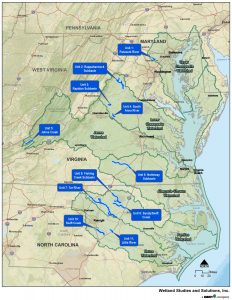Threatened Species Critical Habitat Proposed in MD, VA, NC
The U.S. Fish and Wildlife Service (USFWS) published a proposed rule on February 6, 2020 to officially designate critical habitat for the yellow lance (Eliptio lanceolata), a federally threatened species of freshwater mussel. The proposed critical habitat has been identified along specific reaches of rivers and streams in Maryland, Virginia, and North Carolina.
What is Critical Habitat?

The USFWS has specifically identified 11 watersheds (critical habitat “units”) comprising 319 river miles as proposed critical habitat.
Specifically defined in the Endangered Species Act, critical habitat is specific geographic areas that are determined to be essential to the survival of a species that has been listed as threatened or endangered under the Section 4 of the Endangered Species Act. These areas may require special management considerations or protection (e.g., certain activities may be restricted from occurring in these areas).
Where is the Critical Habitat being designated?
The USFWS has specifically identified 11 watersheds (critical habitat “units”) comprising 319 river miles as proposed critical habitat as follows:
- Patuxent River (Montgomery and Howard Counties, MD) (see map)
- Rappahannock Subbasin (Rappahannock, Fauquier, and Culpeper Counties, VA) (see map)
- Rapidan Subbasin (Madison and Orange Counties, VA) (see map)
- South Anna River (Louisa County, VA) (see map)
- Johns Creek (Craig County, VA) (see map)
- Nottoway Subbasin (Nottoway, Lunenburg, Brunswick, and Dinwiddie Counties, VA) (see map)
- Tar River (Granville, Vance, Franklin, Nash Counties, NC) (see map)
- Sandy/Swift Creek (Vance, Warren, Franklin, Halifax, Nash Counties, NC) (see map)
- Fishing Creek Subbasin (Vance, Warren, Franklin, Halifax, Nash Counties, NC) (see map)
- Swift Creek (Wake and Johnston Counties, NC) (see map)
- Little River (Johnston County, NC) (see map)
What does this mean for me?
Any projects within the designated units requiring Federal Agencies to consult with USFWS under Section 7 of the Endangered Species Act will have to address this species and the critical habitat. Examples of such actions would be wetlands permits, FEMA approvals, or projects with federal funding such as roads.
Threats to the yellow lance within the units vary and include excess sediments from stormwater runoff, high E. coli levels, excessive nitrogen and phosphorus inputs, low pH, low dissolved oxygen, and point source discharges of wastewater. Projects with disturbance within these units may be required to show how they address unit-specific threats.
Questions?
If you have any questions or have a project that could impact an area of proposed critical habitat, please contact Ben Rosner and Bob Kerr in Virginia, and Mike Klebasko in Maryland. If you have comments on the proposed critical habitat for USFWS, they must be received by April 6, 2020.
